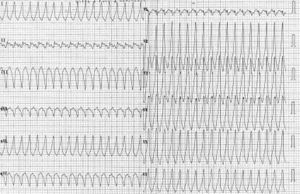Palpitations and Dizziness in a 65-Year-Old-Man: Difference between revisions
Jump to navigation
Jump to search
mNo edit summary |
mNo edit summary |
||
| Line 19: | Line 19: | ||
[[Puzzle_2005_5_189 - Answer|Answer]] | [[Puzzle_2005_5_189 - Answer|Answer]] | ||
Revision as of 19:07, 8 October 2007
| Author(s) | A.A.M. Wilde | |
| NHJ edition: | 2005:5,189 | |
| These Rhythm Puzzles have been published in the Netherlands Heart Journal and are reproduced here under the prevailing creative commons license with permission from the publisher, Bohn Stafleu Van Loghum. | ||
| The ECG can be enlarged twice by clicking on the image and it's first enlargement | ||
A 65-year-old male presented with palpitations and dizziness of sudden onset, without any associated chest pain or other symptoms. His medical history includes an inferior myocardial infarction three years ago, treated with primary percutaneous transluminal coronary angioplasty (PTCA). No acute complications were reported and he had been without symptoms ever since. With the exception of a low blood pressure (90/60 mmHg), physical examination reveals no abnormalities. His ECG is shown in figure 1 (standard calibrations).
What is your diagnosis?
